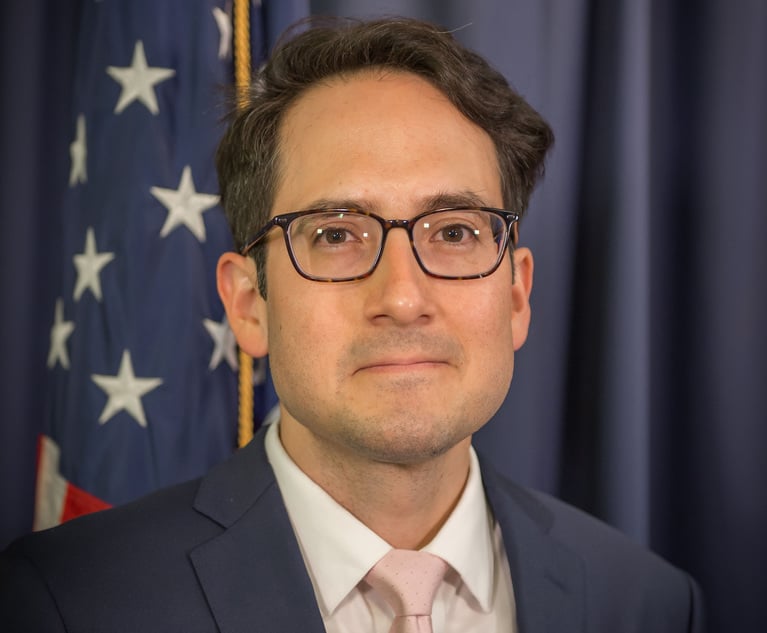The importance of GC succession planning
The leadership profile of todays general counsel as holistic risk manager, strategist and member of the senior management team is represented by many in the Fortune 500, those companies widely regarded as the economic fulcrum of the global economy.
August 04, 2013 at 08:00 PM
7 minute read
The leadership profile of today's general counsel as holistic risk manager, strategist and member of the senior management team is represented by many in the Fortune 500, those companies widely regarded as the economic fulcrum of the global economy. Given the breadth of experience required in the modern profile for the role, it is not surprising that individuals aged 60 years or more hold approximately 25 percent of these positions.
Raising the Consciousness
The implications of this demographic are significant. Based on our empirical experience, general counsel are beginning to think in terms of a serious, methodical approach to succession planning as part of their risk management mandate. To date, however, there are not many companies engaged in robust succession planning for the GC role. But many companies recognize the need to focus on effectuating a seamless transition in this critical leadership role in today's scrutinized and interdependent environment.
It is reasonable to assume that we can expect significant transition in the general counsel role within the Fortune 500 during the next five years. Quantifying the number of likely changes highlights the relevance and need for succession planning methodologies. There is not one common marker, but many factors, that impact when departure is appropriate. Just as certain conditions impact when a CEO might or should depart, emphasizing the critical need for seamless succession planning, many of those same conditions apply to the GC role. If a CEO's long-term mandate is to leave the company in as good, or better, a position as when he took the helm, the same can be said for the general counsel who shares responsibility for the company's reputation, good standing and governance.
The Securities & Exchange Commission (SEC) acted on shareholder concerns for risk associated with company leadership transition, according to the Division of Corporate Finance, by requiring public companies to make CEO succession plans more transparent to shareholders.
In a 2009 bulletin, the division said, “We now recognize that CEO succession planning raises a significant policy issue regarding the governance of the corporation that transcends the day-to-day business matter of managing the workforce. As such, we have reviewed our position on CEO succession planning proposals and have determined to modify our treatment of such proposals. Going forward, we will take the view that a company generally may not rely on Rule 14a-8(i)(7) to exclude a proposal that focuses on CEO succession planning.”
The SEC also commented in the same bulletin, saying, “In addition, we note that there is widespread recognition that the board's role in the oversight of a company's management of risk is a significant policy matter regarding the governance of the corporation. In light of this recognition, a proposal that focuses on the board's role in the oversight of a company's management of risk may transcend the day-to-day business matters of a company and raise policy issues so significant that it would be appropriate for a shareholder vote.”
The implications exist for analogous treatment of general counsel succession by the SEC. The link between the GC's mandate for holistic risk management and corporate governance may foretell a future where the same succession concerns prevail. Organizational succession planning for the general counsel may become a question of legal compliance.
State of the Plan
Many general counsel recognize these concerns well ahead of the actual need to fill a gap. To date, however, succession of the GC generally has been handled in one of three ways. First, the too frequently invoked ad hoc succession, left to chance, or worse, to urgent need. When the general counsel departs, the company can be caught short and the gap may create high risk. Second, there are general counsel who mindfully plan for succession through development of “high potentials,” investing time and attention to preparing these candidates. Some have defined paths to build competencies, such as additional education programs, special projects and rotations into various roles to address perceived gaps. The third are general counsel who take some or all of the actions in the second category, and additionally hire people with a high readiness quotient who are, or who will soon be, ready to take the top role. Arguably, this consideration should be included in every senior-level hire for the legal function.
Interestingly, the growing recognition of the need for strategic succession planning has also given rise to important initiatives geared toward leadership for direct reports to the general counsel. One example is InsideCounsel's underwriting of Project 5/165. The project sponsors invitees' attendance at Development Day workshops for women, in order to optimize the increased number of female Fortune 500 general counsel. The goal is to have 165 women in these top legal roles within five years of the project's launch in 2011.
Filling the Void
What are the implications of a lack of rigor in general counsel succession? How will Fortune 500 boards, CEOs and shareholders navigate the likely transition of 126 (25 percent) or more legal leaders in the coming years?
Absence of a succession plan has consequences that reach beyond the immediate leadership gap for the legal department. Departure risk increases for internal candidates not selected. A valued deputy general counsel fails to obtain the general counsel role only to be recruited as general counsel at another organization. It is difficult to quantify the loss of history, experience and institutional knowledge that leaves the company with such a departure. With such a cost, the need for a succession methodology becomes as important when an organization promotes an internal direct report into the GC role. In that situation, “getting it right” can be a great challenge, since excellent historical performance is only one of many measures in the “best in class” general counsel profile. Even in situations where the GC has sought to develop one or more direct reports as a successor candidate, there may be a lack of understanding of how such people will perform in new and unanticipated situations. Determining an executive's results-orientation and managerial courage through a review of her track record (often the only metric available) does not fully reveal gaps and capabilities beyond those previously demonstrated. Succession tools provide for greater insight as to hidden strengths and future performance. In the case of searches considering external candidates, the lack of robust tools to facilitate may increase the risk of “organ rejection” due to a cultural “miss.”
Constant Transition
The heightened regulatory landscape, globalization of operations and frequency of crisis management has resulted in raised awareness about general counsel succession planning. The “farm team” reporting to the general counsel is likewise thinking more strategically about how to move into the top legal role.
Transition due to succession—whether ad hoc or planned—is a constant, and likely to be a hallmark of the next five years in corporate America. Organizations today can reduce risk through use of well-validated methodologies and tools. Beyond risk mitigation as a critical benefit, there are indirect advantages to be gained. Transparent succession planning methodologies can unite a culture, and provide vision and clarity in leadership profiling and development. It creates a beneficial process for companies and cultures while mitigating the risk and disruption that can otherwise result.
Part 2 of this article will explore methodologies and tools to create a succession planning strategy that connects high-potential talents, motives, beliefs and skills to the needs and strategies of the company.
This content has been archived. It is available through our partners, LexisNexis® and Bloomberg Law.
To view this content, please continue to their sites.
Not a Lexis Subscriber?
Subscribe Now
Not a Bloomberg Law Subscriber?
Subscribe Now
NOT FOR REPRINT
© 2025 ALM Global, LLC, All Rights Reserved. Request academic re-use from www.copyright.com. All other uses, submit a request to [email protected]. For more information visit Asset & Logo Licensing.
You Might Like
View All
GOP Now Holds FTC Gavel, but Dems Signal They'll Be a Rowdy Minority
6 minute read
Trump's Inspectors General Purge Could Make Policy Changes Easier, Observers Say

Keys to Maximizing Efficiency (and Vibes) When Navigating International Trade Compliance Crosschecks
6 minute read
Crypto Industry Eyes Legislation to Clarify Regulatory Framework
Trending Stories
- 1Eighth Circuit Determines No Standing for Website User Concerned With Privacy Who Challenged Session-Replay Technology
- 2Superior Court Re-examines Death of a Party Pending a Divorce Action
- 3Chicago Law Requiring Women, Minority Ownership Stake in Casinos Is Unconstitutional, New Suit Claims
- 4GOP Now Holds FTC Gavel, but Dems Signal They'll Be a Rowdy Minority
- 5Houston-Based Law Firm Overcomes Defamation Suit for Website Warning
Who Got The Work
J. Brugh Lower of Gibbons has entered an appearance for industrial equipment supplier Devco Corporation in a pending trademark infringement lawsuit. The suit, accusing the defendant of selling knock-off Graco products, was filed Dec. 18 in New Jersey District Court by Rivkin Radler on behalf of Graco Inc. and Graco Minnesota. The case, assigned to U.S. District Judge Zahid N. Quraishi, is 3:24-cv-11294, Graco Inc. et al v. Devco Corporation.
Who Got The Work
Rebecca Maller-Stein and Kent A. Yalowitz of Arnold & Porter Kaye Scholer have entered their appearances for Hanaco Venture Capital and its executives, Lior Prosor and David Frankel, in a pending securities lawsuit. The action, filed on Dec. 24 in New York Southern District Court by Zell, Aron & Co. on behalf of Goldeneye Advisors, accuses the defendants of negligently and fraudulently managing the plaintiff's $1 million investment. The case, assigned to U.S. District Judge Vernon S. Broderick, is 1:24-cv-09918, Goldeneye Advisors, LLC v. Hanaco Venture Capital, Ltd. et al.
Who Got The Work
Attorneys from A&O Shearman has stepped in as defense counsel for Toronto-Dominion Bank and other defendants in a pending securities class action. The suit, filed Dec. 11 in New York Southern District Court by Bleichmar Fonti & Auld, accuses the defendants of concealing the bank's 'pervasive' deficiencies in regards to its compliance with the Bank Secrecy Act and the quality of its anti-money laundering controls. The case, assigned to U.S. District Judge Arun Subramanian, is 1:24-cv-09445, Gonzalez v. The Toronto-Dominion Bank et al.
Who Got The Work
Crown Castle International, a Pennsylvania company providing shared communications infrastructure, has turned to Luke D. Wolf of Gordon Rees Scully Mansukhani to fend off a pending breach-of-contract lawsuit. The court action, filed Nov. 25 in Michigan Eastern District Court by Hooper Hathaway PC on behalf of The Town Residences LLC, accuses Crown Castle of failing to transfer approximately $30,000 in utility payments from T-Mobile in breach of a roof-top lease and assignment agreement. The case, assigned to U.S. District Judge Susan K. Declercq, is 2:24-cv-13131, The Town Residences LLC v. T-Mobile US, Inc. et al.
Who Got The Work
Wilfred P. Coronato and Daniel M. Schwartz of McCarter & English have stepped in as defense counsel to Electrolux Home Products Inc. in a pending product liability lawsuit. The court action, filed Nov. 26 in New York Eastern District Court by Poulos Lopiccolo PC and Nagel Rice LLP on behalf of David Stern, alleges that the defendant's refrigerators’ drawers and shelving repeatedly break and fall apart within months after purchase. The case, assigned to U.S. District Judge Joan M. Azrack, is 2:24-cv-08204, Stern v. Electrolux Home Products, Inc.
Featured Firms
Law Offices of Gary Martin Hays & Associates, P.C.
(470) 294-1674
Law Offices of Mark E. Salomone
(857) 444-6468
Smith & Hassler
(713) 739-1250






